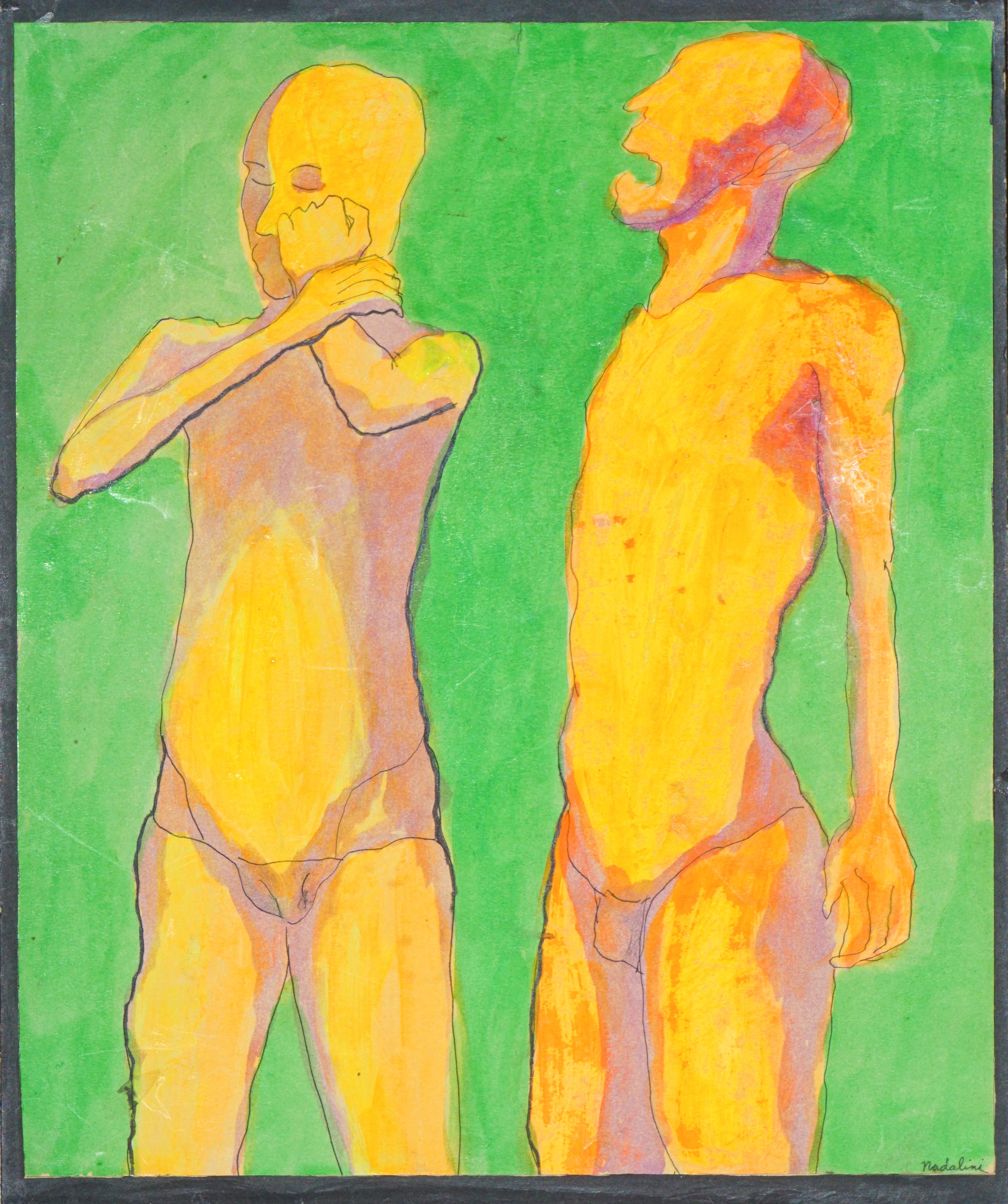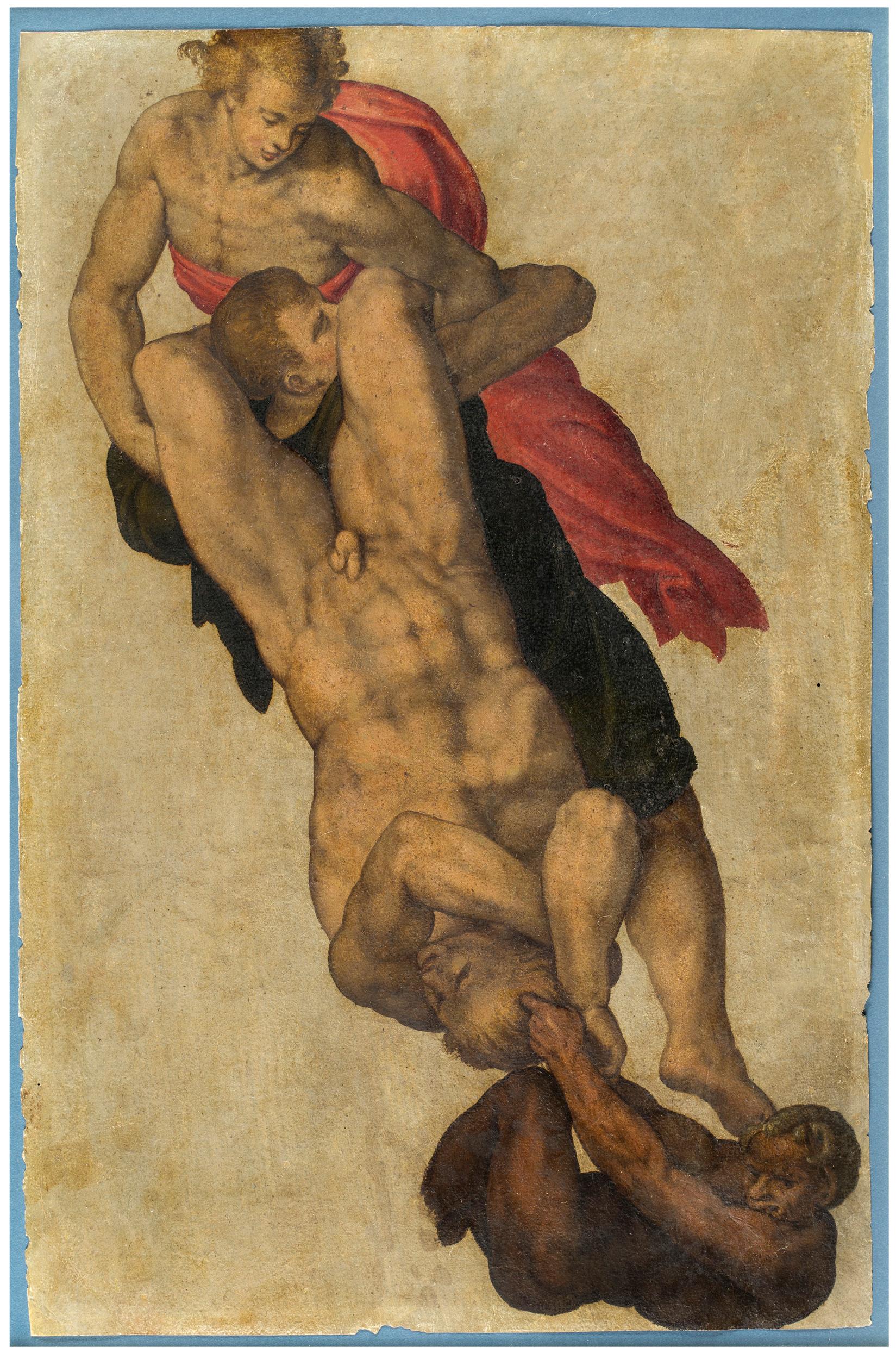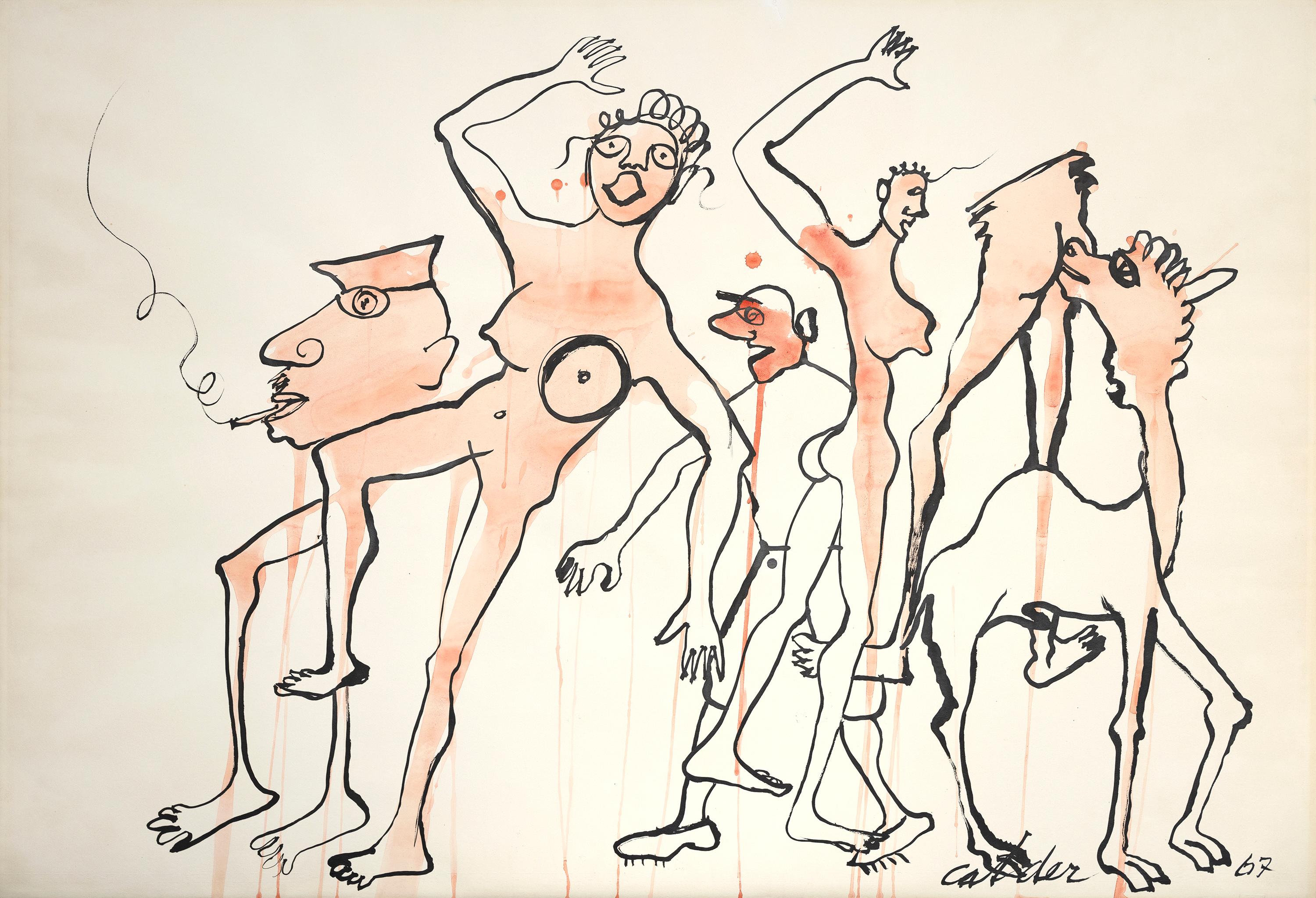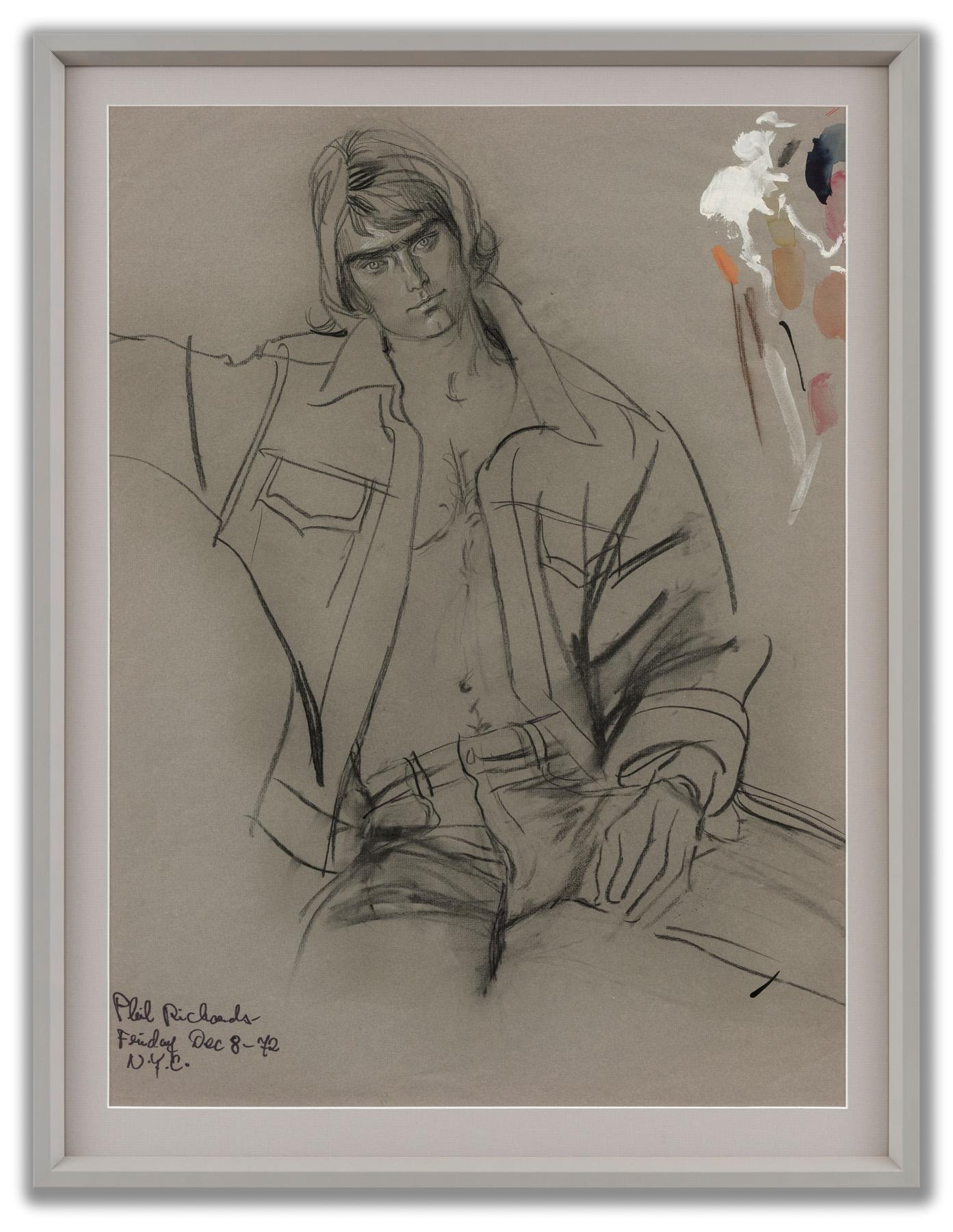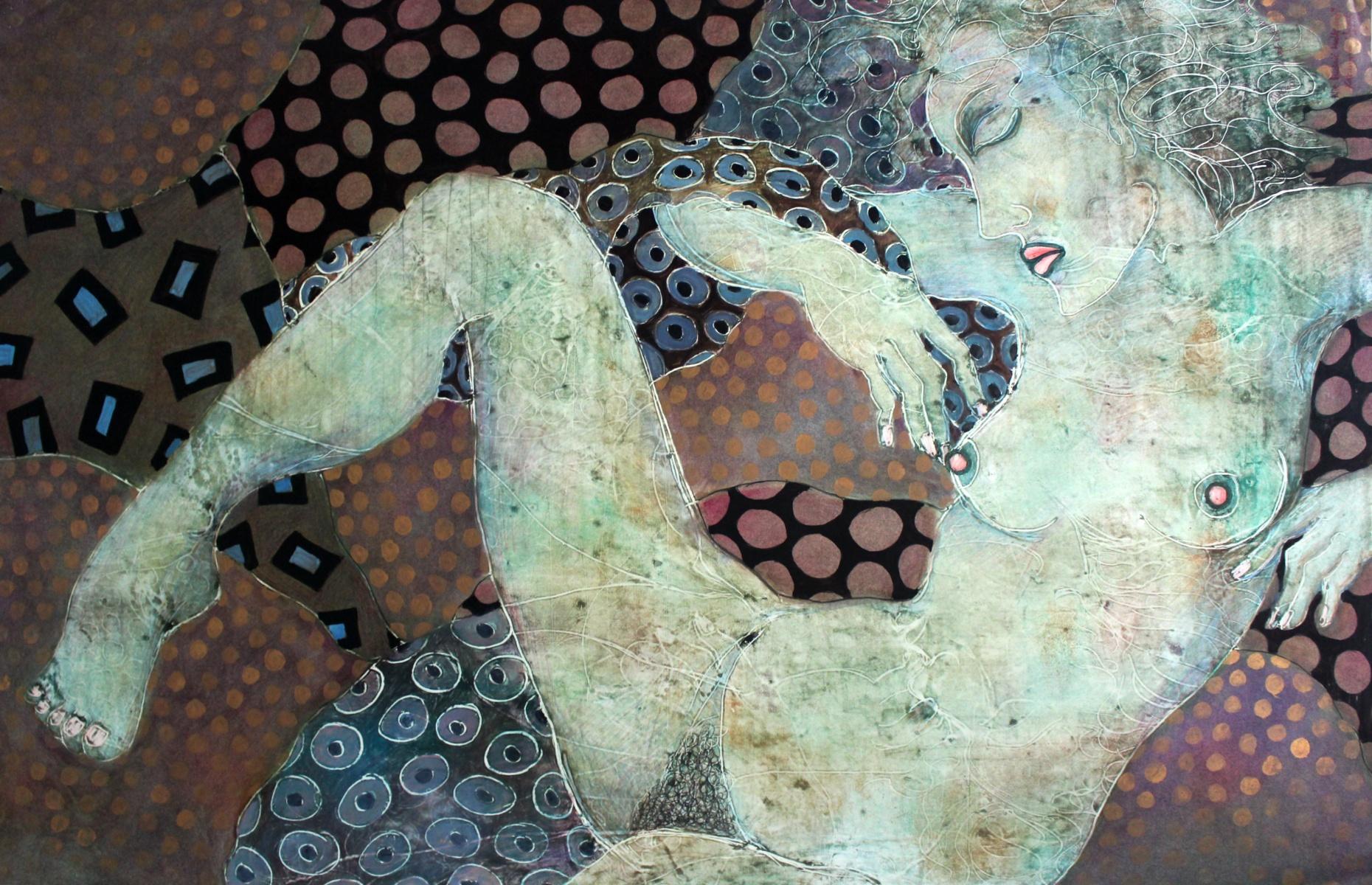Rudy AutioTwo Horses with Female Nude1981
1981
About the Item
- Creator:Rudy Autio (1926, American)
- Creation Year:1981
- Dimensions:Height: 25 in (63.5 cm)Width: 39 in (99.06 cm)
- Medium:
- Movement & Style:
- Period:
- Condition:
- Gallery Location:Missouri, MO
- Reference Number:1stDibs: LU747310308332
Rudy Autio
Rudy Autio is considered one of the most important and influential ceramic artists to ever touch the medium of clay. His masterful works are in permanent collections of museums around the world including the American Craft Museum, the Boston Museum of Fine Arts, the Brooklyn Museum, the Carnegie Museum, the Metropolitan Museum, the Portland Art Museum, the Renwick Gallery of the Smithsonian Institution, the St. Louis Art Museum, the Applied Arts Museum in Helsinki, the National Museum in Stockholm and the Aichi and Shigaraki ceramic museums in Japan. Autio has left an indelible mark on the world with his art. He studied at Washington State University (MFA) and became a professor of ceramics and sculpture at the University of Montana in Missoula (1957). While his early pots reflected abstract expressionism, he is best known for his later figurative work. On anthropomorphic clay forms, he superimposed improvisational drawings of women, landscapes and animals to add pictorial qualities to his vessels. He and Peter Voulkos were the first resident artists at The Archie Bray Foundation in Helena, Montana.
- ShippingRetrieving quote...Ships From: Missouri, MO
- Return PolicyA return for this item may be initiated within 2 days of delivery.
- Lady with Snake HorseBy Rudy AutioLocated in Missouri, MOLady with Snake Horse, 1981 By Rudy Autio (1926-2007) Unframed: 29" x 22.5" Framed: 35.75" x 29.25" Signed and Dated Bottom Right Rudy Autio is a ceramist who was born in Butte, Montana, in 1926, and has lived in his native state throughout most of his career. He headed the ceramics department at the University of Montana for twenty-eight years and is now retired as Professor Emeritus of the School of Fine Arts. Prior to his appointment at the University of Montana, Autio was a founding resident artist at the Archie Bray Ceramics Foundation in Helena, Montana. Autio received a Tiffany Award...Category
20th Century Abstract Animal Drawings and Watercolors
MaterialsWatercolor
- The Necklace and the PotBy Gisella LoefflerLocated in Missouri, MOGisella Loeffler "The Necklace and the Pot" c. 1919 Gouache on Paper Initialed Lower Left Framed Size: approx 15 x 15 inches In a village filled with colorful characters, few Taos artists were as colorful as Gisella Loeffler [1900-1977]. From her handmade Austrian clothing and hand-painted furniture to whimsical paintings and letters written in multicolored crayon, joyful color defined the artist, who early on chose to use simply Gisella as her professional name and was known as such to everyone in Taos. In spite of her fame there—the Taos News once labeled her a Taos legend—Gisella is rarely included in scholarly discussions of the Taos Art Colony. This oversight is likely due to the naive quality of her work, in which children or childlike adults inhabit a simple, brightly colored world filled with happiness. The macabre, the sad, the tortured, the offensive—all have no place in Gisella’s paintings. Her naive style of work looks very different from that of the better-known early Taos artists. Yet both Gisella’s artwork and her interesting life command attention. Born in Austria, Gisella came to the United States with her family in 1908, settling in St. Louis, MO. After studying art at Washington University in St. Louis, she became a prominent member of the local art community, joining the St. Louis Art Guild as well as the Boston Society of Arts and Crafts. In addition to creating posters for the St. Louis Post Dispatch, Gisella won prizes from the Artists Guild of the Author’s League of America in 1919 and 1920 and from the Kansas City Art Institute in 1923. She also began working in textiles, including batik, to which she would return later in her career. In the early 1920s Gisella married writer and music critic Edgar Lacher. A difficult character, Lacher may have chafed under Gisella’s success, for the couple divorced in the 1930s. Having seen a local exhibition of paintings by Taos artists Oscar Berninghaus (who was from St. Louis) and Ernest Blumenschein, Gisella felt drawn to Taos, which reminded her of the villages of her native Austria. In 1933 the single mother with two daughters, Undine and Aithra, moved to Taos, where she lived off and on for the rest of her life. She traveled frequently, spending extended periods in Mexico, South America, and California, but always returned to New Mexico. Gisella initially applied an Austro-Hungarian folk-art style to the Indian and Hispanic subjects that she found in New Mexico. In her early work she covered her surfaces with decorative floral and faunal motifs, and her images were flat with no attempt at rendering traditional one-point perspective. Eventually, though, Gisella developed her own style, often using children or childlike figures as subjects. Still, the influence of her native country’s folk art remained evident in her New Mexican, Mexican, and South American images. In 1938 Gisella moved briefly to Los Griegos, north of Albuquerque, to be closer to medical facilities for her eldest daughter, who was suffering from rheumatic fever. Two years later, she moved to California to participate in the war effort, painting camouflage and decals on airplanes for Lockheed. In California, Gisella broadened her range of artistic pursuits. She taught art privately, created illustrations for Scripts Magazine, and did interior design for private homes. She also designed greeting cards, a practice she continued after her return to New Mexico, where she created a series of Christmas cards. Gisella began illustrating children’s books in 1941 when she collaborated on Franzi and Gizi with author Margery Bianco. Eventually she wrote and illustrated her own book, El Ekeko, in 1964. She also designed ceramics—her Happy Time Dinnerware, marketed by Poppy Trail...Category
1910s Modern Figurative Drawings and Watercolors
MaterialsGouache
- Three GirlsBy Gisella LoefflerLocated in Missouri, MOGisella Loeffler "Three Girlsl" c. 1919 Gouache on Paper Initialed Lower Left Framed Size: approx 19 x 13 inches In a village filled with colorful characters, few Taos artists were as colorful as Gisella Loeffler [1900-1977]. From her handmade Austrian clothing and hand-painted furniture to whimsical paintings and letters written in multicolored crayon, joyful color defined the artist, who early on chose to use simply Gisella as her professional name and was known as such to everyone in Taos. In spite of her fame there—the Taos News once labeled her a Taos legend—Gisella is rarely included in scholarly discussions of the Taos Art Colony. This oversight is likely due to the naive quality of her work, in which children or childlike adults inhabit a simple, brightly colored world filled with happiness. The macabre, the sad, the tortured, the offensive—all have no place in Gisella’s paintings. Her naive style of work looks very different from that of the better-known early Taos artists. Yet both Gisella’s artwork and her interesting life command attention. Born in Austria, Gisella came to the United States with her family in 1908, settling in St. Louis, MO. After studying art at Washington University in St. Louis, she became a prominent member of the local art community, joining the St. Louis Art Guild as well as the Boston Society of Arts and Crafts. In addition to creating posters for the St. Louis Post Dispatch, Gisella won prizes from the Artists Guild of the Author’s League of America in 1919 and 1920 and from the Kansas City Art Institute in 1923. She also began working in textiles, including batik, to which she would return later in her career. In the early 1920s Gisella married writer and music critic Edgar Lacher. A difficult character, Lacher may have chafed under Gisella’s success, for the couple divorced in the 1930s. Having seen a local exhibition of paintings by Taos artists Oscar Berninghaus (who was from St. Louis) and Ernest Blumenschein, Gisella felt drawn to Taos, which reminded her of the villages of her native Austria. In 1933 the single mother with two daughters, Undine and Aithra, moved to Taos, where she lived off and on for the rest of her life. She traveled frequently, spending extended periods in Mexico, South America, and California, but always returned to New Mexico. Gisella initially applied an Austro-Hungarian folk-art style to the Indian and Hispanic subjects that she found in New Mexico. In her early work she covered her surfaces with decorative floral and faunal motifs, and her images were flat with no attempt at rendering traditional one-point perspective. Eventually, though, Gisella developed her own style, often using children or childlike figures as subjects. Still, the influence of her native country’s folk art remained evident in her New Mexican, Mexican, and South American images. In 1938 Gisella moved briefly to Los Griegos, north of Albuquerque, to be closer to medical facilities for her eldest daughter, who was suffering from rheumatic fever. Two years later, she moved to California to participate in the war effort, painting camouflage and decals on airplanes for Lockheed. In California, Gisella broadened her range of artistic pursuits. She taught art privately, created illustrations for Scripts Magazine, and did interior design for private homes. She also designed greeting cards, a practice she continued after her return to New Mexico, where she created a series of Christmas cards. Gisella began illustrating children’s books in 1941 when she collaborated on Franzi and Gizi with author Margery Bianco. Eventually she wrote and illustrated her own book, El Ekeko, in 1964. She also designed ceramics—her Happy Time Dinnerware, marketed by Poppy Trail...Category
1910s Modern Figurative Drawings and Watercolors
MaterialsGouache
- Mother and Child In the GardenBy Gisella LoefflerLocated in Missouri, MOGisella Loeffler "Mother and Child in the Gardenl" 1919 Gouache on Paper Initialed Lower Right Framed Size: approx 19 x 10 3/4 inches In a village filled with colorful characters, few Taos artists were as colorful as Gisella Loeffler [1900-1977]. From her handmade Austrian clothing and hand-painted furniture to whimsical paintings and letters written in multicolored crayon, joyful color defined the artist, who early on chose to use simply Gisella as her professional name and was known as such to everyone in Taos. In spite of her fame there—the Taos News once labeled her a Taos legend—Gisella is rarely included in scholarly discussions of the Taos Art Colony. This oversight is likely due to the naive quality of her work, in which children or childlike adults inhabit a simple, brightly colored world filled with happiness. The macabre, the sad, the tortured, the offensive—all have no place in Gisella’s paintings. Her naive style of work looks very different from that of the better-known early Taos artists. Yet both Gisella’s artwork and her interesting life command attention. Born in Austria, Gisella came to the United States with her family in 1908, settling in St. Louis, MO. After studying art at Washington University in St. Louis, she became a prominent member of the local art community, joining the St. Louis Art Guild as well as the Boston Society of Arts and Crafts. In addition to creating posters for the St. Louis Post Dispatch, Gisella won prizes from the Artists Guild of the Author’s League of America in 1919 and 1920 and from the Kansas City Art Institute in 1923. She also began working in textiles, including batik, to which she would return later in her career. In the early 1920s Gisella married writer and music critic Edgar Lacher. A difficult character, Lacher may have chafed under Gisella’s success, for the couple divorced in the 1930s. Having seen a local exhibition of paintings by Taos artists Oscar Berninghaus (who was from St. Louis) and Ernest Blumenschein, Gisella felt drawn to Taos, which reminded her of the villages of her native Austria. In 1933 the single mother with two daughters, Undine and Aithra, moved to Taos, where she lived off and on for the rest of her life. She traveled frequently, spending extended periods in Mexico, South America, and California, but always returned to New Mexico. Gisella initially applied an Austro-Hungarian folk-art style to the Indian and Hispanic subjects that she found in New Mexico. In her early work she covered her surfaces with decorative floral and faunal motifs, and her images were flat with no attempt at rendering traditional one-point perspective. Eventually, though, Gisella developed her own style, often using children or childlike figures as subjects. Still, the influence of her native country’s folk art remained evident in her New Mexican, Mexican, and South American images. In 1938 Gisella moved briefly to Los Griegos, north of Albuquerque, to be closer to medical facilities for her eldest daughter, who was suffering from rheumatic fever. Two years later, she moved to California to participate in the war effort, painting camouflage and decals on airplanes for Lockheed. In California, Gisella broadened her range of artistic pursuits. She taught art privately, created illustrations for Scripts Magazine, and did interior design for private homes. She also designed greeting cards, a practice she continued after her return to New Mexico, where she created a series of Christmas cards. Gisella began illustrating children’s books in 1941 when she collaborated on Franzi and Gizi with author Margery Bianco. Eventually she wrote and illustrated her own book, El Ekeko, in 1964. She also designed ceramics—her Happy Time Dinnerware, marketed by Poppy Trail...Category
1910s Modern Figurative Drawings and Watercolors
MaterialsGouache
- Going for a StrollBy Gisella LoefflerLocated in Missouri, MOGisella Loeffler "Going for a Stroll" c. 1919 Gouache on Paper Initialed Framed Size: approx 17 x 13 inches In a village filled with colorful characters, few Taos artists were as colorful as Gisella Loeffler [1900-1977]. From her handmade Austrian clothing and hand-painted furniture to whimsical paintings and letters written in multicolored crayon, joyful color defined the artist, who early on chose to use simply Gisella as her professional name and was known as such to everyone in Taos. In spite of her fame there—the Taos News once labeled her a Taos legend—Gisella is rarely included in scholarly discussions of the Taos Art Colony. This oversight is likely due to the naive quality of her work, in which children or childlike adults inhabit a simple, brightly colored world filled with happiness. The macabre, the sad, the tortured, the offensive—all have no place in Gisella’s paintings. Her naive style of work looks very different from that of the better-known early Taos artists. Yet both Gisella’s artwork and her interesting life command attention. Born in Austria, Gisella came to the United States with her family in 1908, settling in St. Louis, MO. After studying art at Washington University in St. Louis, she became a prominent member of the local art community, joining the St. Louis Art Guild as well as the Boston Society of Arts and Crafts. In addition to creating posters for the St. Louis Post Dispatch, Gisella won prizes from the Artists Guild of the Author’s League of America in 1919 and 1920 and from the Kansas City Art Institute in 1923. She also began working in textiles, including batik, to which she would return later in her career. In the early 1920s Gisella married writer and music critic Edgar Lacher. A difficult character, Lacher may have chafed under Gisella’s success, for the couple divorced in the 1930s. Having seen a local exhibition of paintings by Taos artists Oscar Berninghaus (who was from St. Louis) and Ernest Blumenschein, Gisella felt drawn to Taos, which reminded her of the villages of her native Austria. In 1933 the single mother with two daughters, Undine and Aithra, moved to Taos, where she lived off and on for the rest of her life. She traveled frequently, spending extended periods in Mexico, South America, and California, but always returned to New Mexico. Gisella initially applied an Austro-Hungarian folk-art style to the Indian and Hispanic subjects that she found in New Mexico. In her early work she covered her surfaces with decorative floral and faunal motifs, and her images were flat with no attempt at rendering traditional one-point perspective. Eventually, though, Gisella developed her own style, often using children or childlike figures as subjects. Still, the influence of her native country’s folk art remained evident in her New Mexican, Mexican, and South American images. In 1938 Gisella moved briefly to Los Griegos, north of Albuquerque, to be closer to medical facilities for her eldest daughter, who was suffering from rheumatic fever. Two years later, she moved to California to participate in the war effort, painting camouflage and decals on airplanes for Lockheed. In California, Gisella broadened her range of artistic pursuits. She taught art privately, created illustrations for Scripts Magazine, and did interior design for private homes. She also designed greeting cards, a practice she continued after her return to New Mexico, where she created a series of Christmas cards. Gisella began illustrating children’s books in 1941 when she collaborated on Franzi and Gizi with author Margery Bianco. Eventually she wrote and illustrated her own book, El Ekeko, in 1964. She also designed ceramics—her Happy Time Dinnerware, marketed by Poppy Trail...Category
1910s Modern Figurative Drawings and Watercolors
MaterialsGouache
- L'EgliseBy Maurice UtrilloLocated in Missouri, MOMaurice Utrillo (1883-1955) "L'Eglise" (Petrides No 25.562) Created 1937 Signed and Dated Lower Right Without Frame: 11" x 8.75" With Frame: 21" x 17.5" Provenance: Galerie Gilbert ...Category
Late 19th Century French School Landscape Drawings and Watercolors
MaterialsWatercolor, Paper, Gouache
- Florescent Figurative AbstractBy Louis NadaliniLocated in Soquel, CAEvocative figurative abstract in florescent hues by Louis Nadalini (American, 1927-1995). Signed lower right corner and dated "Louis E Nadalini 88" on verso. Unframed. Louis Nadali...Category
1980s Abstract Expressionist Drawings and Watercolor Paintings
MaterialsGouache, Paper, Pastel
- Study after Michelangelo’s “The Last Judgment”By Michelangelo BuonarrotiLocated in New York, NYItalian School, 16th Century Provenance: Private Collection, New York This intriguing drawing is a study by an anonymous 16th-century Italian artist after a vignette in Michelangelo’s fresco of The Last Judgement in the Sistine Chapel. The altar wall of the Sistine Chapel was already richly decorated when Pope Clement VII commissioned Michelangelo to paint his Last Judgment...Category
16th Century Old Masters Figurative Drawings and Watercolors
MaterialsGouache, Paper
- PersonnagesBy Alexander CalderLocated in Palm Desert, CA"Personnages" is a gouache on paper by Alexander Calder. The work is signed in the lower right, "Calder 67". Although renowned for his innovative and groundbreaking sculptures, Alex...Category
1960s Figurative Drawings and Watercolors
MaterialsInk, Paper, Gouache
- Phil RichardsBy Brian StonehouseLocated in London, GBCharcoal and gouache on paper, titled ‘Phil Richards’ and dated ‘Friday Dec 8 72’ (lower left), 64cm x 48cm (72cm x 56cm framed).(Provenance: the Artist’s estate (stamped verso)). the picture is framed behind UV glass Stonehouse had an extraordinary life. As a young art student studying fashion illustration, he joined the Royal Artillery at the beginning of WWII but soon became a part of the Special Operations Executive (SOE). He was sent to France as a radio operator but three and a half months later was caught by the Gestapo, tortured, given a death sentence and then selected for slave labour. He spent the subsequent war years in three French prisons and five concentration and labour camps, including Dachau. He still managed to continue to draw in some of the camps. Following the war, Stonehouse went to the US and continued his career as a fashion artist painting for magazines like Vogue, Harper's Bazaar and Elizabeth Arden. He was also an accomplished portraitist. His work is celebrated in Brian Stonehouse...Category
1970s Post-War Figurative Drawings and Watercolors
MaterialsPaper, Charcoal, Gouache
- Nude - XXI Century, Contemporary Gouache and Charcoal Figurative Drawing, FemaleBy Marta ŁebekLocated in Warsaw, PLMarta Lebek is a Polish artist born in 1978. She currently lives and works in Spain. She studied at the School of Fine Arts and specialized in the departm...Category
21st Century and Contemporary Expressionist Figurative Drawings and Wate...
MaterialsPaper, Charcoal, Gouache
- Don't wake up the princess - XX Century, Mixed Media Figurative Painting, NudeBy Katarzyna WazykLocated in Warsaw, PLGabryela Wasowicz is a Polish painter born in 1947. She studied at the Academy of Fine Arts of Warsaw and then at the Gerrit Rietveld Akademie in Amsterdam. Once she graduated in 197...Category
1980s Contemporary Nude Drawings and Watercolors
MaterialsPaper, Pastel, Watercolor, Gouache
